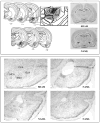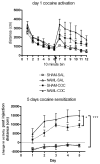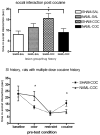Neonatal amygdala lesions: co-occurring impact on social/fear-related behavior and cocaine sensitization in adult rats
- PMID: 18085884
- PMCID: PMC2895979
- DOI: 10.1037/0735-7044.121.6.1316
Neonatal amygdala lesions: co-occurring impact on social/fear-related behavior and cocaine sensitization in adult rats
Abstract
Neurodevelopmental abnormalities of temporal-limbic structures may underlie both adult psychiatric syndromes and increased addiction vulnerability, leading to high frequencies of "dual diagnosis" disorders. Although the amygdala is implicated in various mental disorders and drug addiction, no studies have explored the impact of early developmental damage to the amygdala on phenotypes relating to mental illness and addictions as co-occurring processes. We tested rats with neonatal amygdala lesions (NAML) vs. SHAM-operated controls in a battery of tests--novel field activity, elevated plus maze (EPM), and social interaction (SI) at baseline and after odor and restraint stress--followed by measures of cocaine sensitization (15 mg/kg vs. saline x 5 days + challenge session 2 weeks later) and remeasurement of SI. NAMLs showed increased novelty-related locomotion, less fear responding in the EPM, and resistance to predator-odor- but not to restraint-induced suppression of SI. NAMLs also had elevated cocaine sensitization profiles, and cocaine history differentially affected subsequent SI in NAMLs compared with SHAMs. NAMLs may provide models for understanding a shared neurobiological basis for and complex interactions among psychiatric symptoms, drug exposure history, and addiction vulnerability.
Figures







Similar articles
-
Toward early estimation and treatment of addiction vulnerability: radial arm maze and N-acetyl cysteine before cocaine sensitization or nicotine self-administration in neonatal ventral hippocampal lesion rats.Psychopharmacology (Berl). 2016 Dec;233(23-24):3933-3945. doi: 10.1007/s00213-016-4421-8. Epub 2016 Sep 17. Psychopharmacology (Berl). 2016. PMID: 27640177 Free PMC article.
-
High-novelty-preference rats are predisposed to compulsive cocaine self-administration.Neuropsychopharmacology. 2011 Feb;36(3):569-79. doi: 10.1038/npp.2010.188. Epub 2010 Oct 27. Neuropsychopharmacology. 2011. PMID: 20980989 Free PMC article.
-
Denial or receipt of expected reward through maternal contact during the neonatal period differentially affect the development of the rat amygdala and program its function in adulthood in a sex-dimorphic way.Psychoneuroendocrinology. 2013 Sep;38(9):1757-71. doi: 10.1016/j.psyneuen.2013.02.012. Epub 2013 Mar 13. Psychoneuroendocrinology. 2013. PMID: 23490071
-
Activation of corticotropin releasing factor-containing neurons in the rat central amygdala and bed nucleus of the stria terminalis following exposure to two different anxiogenic stressors.Behav Brain Res. 2016 May 1;304:92-101. doi: 10.1016/j.bbr.2016.01.051. Epub 2016 Jan 25. Behav Brain Res. 2016. PMID: 26821289 Free PMC article.
-
Repeated formaldehyde effects in an animal model for multiple chemical sensitivity.Ann N Y Acad Sci. 2001 Mar;933:57-67. doi: 10.1111/j.1749-6632.2001.tb05814.x. Ann N Y Acad Sci. 2001. PMID: 12000036 Review.
Cited by
-
Transcranial magnetic stimulation: potential treatment for co-occurring alcohol, traumatic brain injury and posttraumatic stress disorders.Neural Regen Res. 2014 Oct 1;9(19):1712-30. doi: 10.4103/1673-5374.143408. Neural Regen Res. 2014. PMID: 25422632 Free PMC article. Review.
-
Cortical-striatal gene expression in neonatal hippocampal lesion (NVHL)-amplified cocaine sensitization.Genes Brain Behav. 2013 Jul;12(5):564-75. doi: 10.1111/gbb.12051. Epub 2013 Jun 22. Genes Brain Behav. 2013. PMID: 23682998 Free PMC article.
References
-
- Adolphs R, Tranel D, Damasio AR. The human amygdala in social judgment. Nature. 1998;393:470–474. - PubMed
-
- American Psychological Association. Ethical principles of psychologists and code of conduct. Washington, DC: Author; 2002.
-
- Anand A, Shekhar A. Brain imaging studies in mood and anxiety disorders: Special emphasis on the amygdala. Annals of the New York Academy of Sciences. 2003;985:370–388. - PubMed

